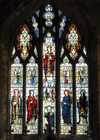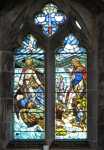For this church:    |
Perlethorpe St JohnGlass
1The Great East WindowThis window replaced the previous in 1911, and depicts the Ascension of Christ to Glory, surrounded by angels and incorporates four Saints. At its dedication service, the address explained that the four saints depicted were:-
The East window was dedicated on Trinity Sunday in 1911 at a service given by the Rev William Berry Cardew, Earl Manvers reading the lesson and the Rev Henry Telford Hayman preaching. He spoke on the wide sympathies, helpfulness and worthy lives of those in loving remembrance of those to whom it was given. The window is in overall terms a modern piece of workmanship, but the detail is second to none. Careful viewing of the striations and depth of colour on the glass itself, particularly those depicting various items of clothing, clearly indicate a master of his art has been employed. The varying directions of these striations, depending on the shape of the fabric depicted gives a hidden depth to the work. Similarly the placement of the glass within the lead joints at varying depths gives a further added perspective and the depth of colour give credit to the celebration of the Ascension of Christ in all His Glory.
Of greatest prominence, in the upper part of the central light, is the figure of Christ in glory, King of Kings and Lord of Lords. The figure is adorned in a red cloak with golden border, a white under-robe, and holding an orb. You will note Jesus has a wound in each of His feet caused by the nails during His crucifixion. Below this figure are two angels are poised to give service, one supporting a corded censer or thurible, the other, a lyre or harp. In the lower part of the light is a nativity scene: baby Jesus within a crib overlooked by Mother Mary clothed in a blue cloak and white head cover, with three faces of members of the Heavenly Host. In the very top light is a representation of the Holy Spirit as a dove, flanked by Alpha and Omega symbols and two angelic heads. Two six-winged angelic figures occupy the upper side lights, proclaiming the Sanctus: Holy, Holy, Holy In the upper part of the four side lights are four angels, one holding a bunch of lilies, one a branch of olive, one the Crown of Thorns, and the other a palm. Above them in four small circles are the Holy Dove, a sunburst, the three nails (of the crucifixion) and a crown. Below the angels, reading right across the window, are the opening words of the Te Deum Laudamus: We praise Thee O God We acknowledge Thee to be the Lord Other wrds from the Te Deum can also be found in the window: By the figure of the Dove at the top are the words: The Holy Ghost the Comforter and furthe down in the window, from near the end of the canticle: Day by day we magnify Thee Within the lower parts of the four side lights, which have a background of oak tree branches, with leaves and acorns adorning them, the following four Saints are positioned. St Martin of ToursThis first Saint, placed at the left of the window, depicts St Martin of Tours. The work on this section of the window incorporates some of the most exacting if not lavish detail. His stunning blue cope with a white lining and gold trefoils incorporates a border with such fine detail it’s hard to distinguish it from real fabric. The cope is fastened together with a morse or clasp, which supports a magnificent red jewel. His alb incorporates a gold embroidered pattern matched against a further patterned red stole with golden tassels. St Martin is also provided with a Bishops mitre and is carrying a Crosier of gold with an effigy of the Lamb of God within its crook. Careful examination of this detail within the border will reveal a relief of a young man cutting his cloak in two and giving half to a beggar. Martin is traditionally depicted as dividing his cloak in two and giving one piece to a half naked beggar - an incident alleged to have taken place at Amiens. This most Christian of acts is depicted, as noted, within the border of the cope he is wearing, within the picture on the East window. St John the EvangelistOur second saint, St John, who is wearing a cloak in red over a vivid green orphrey, with a white alb, and holds in his left hand a golden chalice. Whilst traditions have had a more direct influence on artistic representations, the viper which is in memory of the challenge to him by a high priest of Diana at Ephesus to drink a poisoned cup, is missing from the chalice in this instance. The other symbol is a book, which is being held in the right hand. John is patron of theologians, writers, and all who work at the production of books, as well as being the writer of the fourth gospel. St JamesThe third panel incorporates a saint, which was assigned when the window was dedicated, according to the presentation by Charles William Sydney Pierrepont, the 4th Earl Manvers, to St James the Less. This image was selected as the 3rd Earl and his wife Georgine loved to read James’ Epistle. Here begins a conundrum. Considering the window image gives a splendid picture of St James with all the elements of perspective, density and glass striations. The deep blue cloak incorporates a subtle black line design of scallop shells around its border. The brown alb is adequately depicted within the perspective. It will also be noted James wears no shoes, but a toeless stocking, as distinct from the others. Within his left hand he supports a hooked staff upon which a vessel is being carried. From the information gleaned from the glass image, one could reflect on the previously reported reasons given, for James to be included in the window. However, images of James, which bear iconographic features such as a pilgrims’ hat and scallop shell associated with Compostella, and carrying a staff, are those of St James the Great. Whilst we do not have the hat, the scallop shell and staff are clearly shown within the window. The situation is further confused as the Epistle of James is always held to be the work of St James of Jerusalem, the brother of Jesus, quite a different person from either St James the Great (the brother of St John) or St James the Less (the apostle, described as the son of Alphaeus). St MargaretThe fourth Saint, depicted in the window, is St Margaret (1046-93), a Queen of Scotland, who is looking north within the window structure, with due reverence to our Lord. She holds a book in her right hand and a crucifix in her left. Margaret was Grand-daughter of Edmund Ironside and daughter of Edward the Atheling (d.1057) and was mainly educated in Hungary, where her family were exiled during the rule of Danish kings in England. As one of the last members of the Anglo-Saxon royal family, she was in danger after the Norman Conquest and took refuge at the court of Malcolm III king of Scotland. They were married in 1069. Her private life was devoted to prayer, reading, lavish almsgiving, and to ecclesiastical needlework.
Along the bottom of the window is the dedication:
The fourth Earl unveiled the window on the 11th June 1911 as a memorial to his father, who had passed away on the 16th January 1900; and his mother Georgine Jane Elizabeth Fanny Pierrepont Dowager Countess Manvers, who joined her husband, and was buried on the 2nd August 1910, adjacent to her husband, in the churchyard of St John’s. 2The Good Samaritan Window
Behind the priest’s dais and chair, in the Chancel, a stained glass window is fitted, reported as being from the old Church (1744), depicting the Parable of the Good Samaritan, in a rather confused order; perhaps to promote debate? The window is etched ‘Lavers Barraud & Westlake - London 1881' on what would have been the original section of the window moved from the previous church (1774). The Marshall family who lived in the Parish in the 17th and 18th centuries provided this window and it is marked:- This window is erected in memory of Isaac Marshall, Isaac Marshall his son who died in 1734, and his son Isaac Marshall who died in 1786 who with others of their family are buried in the adjoining churchyard by George William Marshall RIP great grandson of the last named Isaac Marshall AD 1881 The 1764 Palethorpe Chapel Terrier indicates one Isaac Marshall as the Church Warden. The burial sites mentioned above are to be found in the south-eastern part of the churchyard. 3Window depicting Ruth gleaning in the fields
Before leaving the Nave, moving across to the South Aisle, a stained glass window to the south of the lectern shows a particularly vivid picture of Ruth gleaning in the fields of her future husband Boaz. (Ruth 2:3) This window has a modernistic style of glass painting with loose brushwork and colouring. Some considerable divergence of colour is made from ochre to blue in the lower section of the left window. The canine in the right section does not appear to have the character of an Aramaic breed and looks remarkably well fed, perhaps a friend from a more recent time? Scripture informs us that the peaceful story of Ruth is set in the violent times of the Book of Judges, between the invasion of Canaan and the establishment of the monarchy. Ruth was a Moabite woman and married to an Israelite until his unfortunate death. Ruth then shows an uncommon loyalty to her Israelite mother-in-law and deep devotion to the God of Israel. In the end, she finds a new husband among her former husband’s relatives, and through this marriage becomes the great-grandmother of David, Israel’s greatest king. The top of the window reveals the hermit St Giles who is struck by an arrow intended for his pet deer. This window is in memory of Gervas Evelyn Pierrepont (1881-1955), the sixth Earl Manvers.
| |||||||||||||||||||||||||||||||












